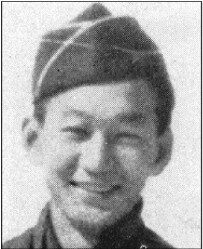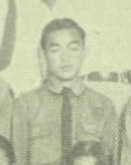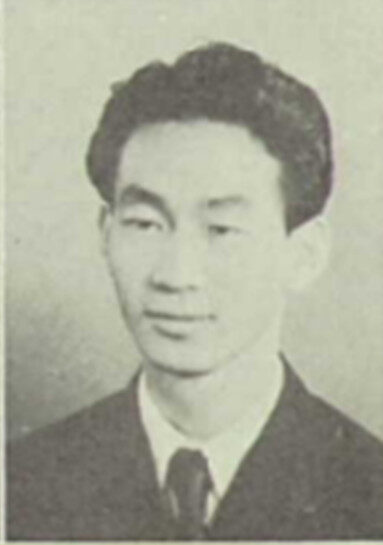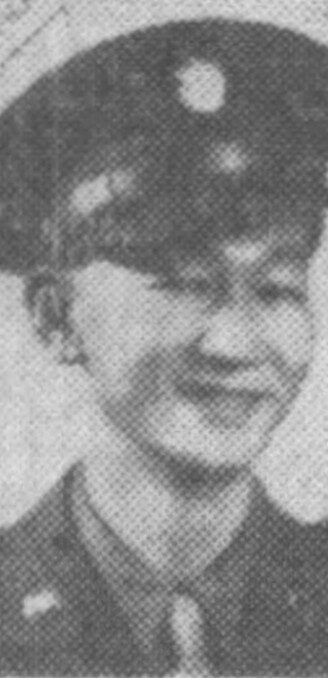Soldier Story: Wilfred Masao Motokane
Soldier Story

Wilfred Masao Motokane
Technician 4th Grade
U.S. Army
Military Intelligence Service
Wilfred Masao Motokane was born on July 12, 1915, in Honolulu, Territory of Hawaii, to Motojiro and Mitsuno (Sumida) Motokane. Masao was the second oldest of six children. He had an older brother, Sadao, and two older sisters Mary Shizuko and Yoshiko, and two younger sisters, Grace Yoshie and Violet Teruko. Motojiro and Mitsuno emigrated from the village of Okukaida, Hiroshima Prefecture, Japan. Motojiro arrived in Honolulu on March 13, 1908, on the Nippon Maru. Mitsuno arrived on July 8, 1908, on the Korea Maru. Motojiro initially worked as a fisherman.

In 1930, the family was living at 11-12 Iwilei Road. Father Motojiro was employed as a foreman at the gasworks. Masao attended Kalakaua Intermediate School and McKinley High School.
Right: 1931 Sophomore class photo from McKinley
In high school, he was a member of the Senior Senate, Representative Assembly, Japanese Students Association, Boys’ Advisory Board, and Office Training Club where he was Treasurer. He also played baseball in the local Japanese American baseball leagues, and earned many trophies as a pitcher. As a member of the graduating class of 1933, Masao Motokane received a Certificate of Honor.
Below: 1933 Senior class photo from McKinley

After graduating from McKinley, Masao continued his education at the Margaret Dietz Commercial School, graduating in 1937. He won numerous awards for participation in the International Gregg Writing Contests. He was the general chairman for the school dance committee and Vice President of the graduating class of 1937. Masao was also the recipient of membership into the International Honor Society for Business Education.
On February 16, 1937, he married Shizuye Nakamura in Honolulu. She was the daughter of Seiichi and Tatsu Nakamura of Honolulu, immigrants from Yamaguchi Prefecture. In 1940, Masao and Shizuye were living at 2028 Citron Street with their son. Masao was employed as a substitute mail clerk at the post office.
Masao Motokane registered for the draft on October 26, 1940, at Local Board No. 6, OR&L Depot, Honolulu. His point of contact was his wife, Shizuye, and they lived at 614 Iwilei Road. Masao was employed as a clerk at the U.S. Post Office at Merchant & Richards Streets. He was 5’8” tall and weighed 128 pounds.
On December 27, 1943, Masao and Shizuye officially had their names changed to Wilfred Masao and Sheila Shizuye Motokane, by order of Governor Ingram M. Stainback.
As a postal service worker, he was exempt from the draft. However, Motokane and 44 other Japanese Americans working for the local postal service decided to volunteer together. These men set the record for the percentage of a workplace that volunteered for the U.S. Army. He enlisted in the Army on January 3, 1944, in Honolulu. His civilian occupation was listed as “Stenographers and typists.”
A month later, Wilfred had been assigned to the Military Intelligence Service and he started training at the Military Intelligence Service Language School (MISLS) at Camp Savage, Minnesota. His Class 44-02 was the largest ever in the school’s history. The course covered many aspects of the Japanese language including reading, writing, speaking, and translating different styles of Japanese. The duration of the training was also increased from six to nine months with the start of Motokane’s class.

After graduation, Motokane was sent to Fort McClellan, Alabama, for eight weeks of basic training.
Right: Motokane about 1944
Wilfred Motokane was then assigned to the ATIS (Allied Translator and Interpreter Service), and sent to the Philippines in early 1945. In the Philippines, he was assigned to the 306th Counter Intelligence Corps Detachment (CIC), which was attached to the 11th Airborne Division.
After the bombings of Hiroshima and Nagasaki on August 6 and 9, 1945, Technician 4th Grade Wilfred M. Motokane was flying from a six-week tour in Manila, Philippine Islands, on a C-46 into Naha, Okinawa, on August 13. As the plane approached the airfield about 9:00 p.m., an air raid alert went out. Ships offshore sent out a smoke screen against Kamikaze attacks, and the airfield turned its lights off. After two unsuccessful attempts to land in the smoke with no lights, on the third attempt the airplane crashed into a cliff, killing everyone on board: four crew, 12 paratroopers of the 11th Airborne Division, five Counter Intelligence men, and 10 MIS linguists, including Motokane. He was buried in the U.S. Military Cemetery in Okinawa. Two days after the airplane crash, Japan surrendered, thus ending World War II.
For his military service, Technician Fourth Grade Wilfred Masao Motokane was awarded the Purple Heart Medal, Good Conduct Medal, Asiatic-Pacific Campaign Medal, and World War II Victory Medal. He was posthumously awarded the Congressional Gold Medal on October 5, 2010, along with the other members of the Military Intelligence Service and the 100th/442nd Regimental Combat Team. The award states: “The United States remains forever indebted to the bravery, valor, and dedication to country these men faced while fighting a 2-fronted battle of discrimination at home and fascism abroad. Their commitment and sacrifice demonstrates a highly uncommon and commendable sense of patriotism and honor.”
A memorial service was held for Motokane on September 2, 1945, at 11:00 a.m. at the Honpa Hongwanji Mission Temple on Upper Fort Street in Honolulu. Survivors included his wife Sheila Shizuye, son Wilfred Masao Jr., parents, and siblings Sadao, Mary Shizuko Manabe, Yoshiko Urata, Grace Yoshie Numazu, and Violet Teruko Hoshibata.
On May 30, 1948, Honpa Hongwanji Mission Temple dedicated a Memorial Plaque to the Hawaii Japanese American soldiers who had been killed during the war and were Buddhists. The plaque contains the name of Wilfred M. Motokane, and his son was one of four children chosen to unveil the plaque bearing the names of their fathers.
Below: Memorial Plaque dedication, May 30, 1948. Wilfred Motokane Jr. is second from right wearing a Boy Scout uniform with his head bowed

As a result of a program instituted in 1947 to return our war dead to the United States if the family so desired, the flag-draped casket containing the remains of Technician Fourth Grade Wilfred Masao Motokane was returned to Hawaii. The casket was placed at the Army mausoleum at Schofield Barracks awaiting burial arrangements. He was interred on August 24, 1949, at the National Memorial Cemetery of the Pacific at Punchbowl in Section D, Site 248. The graveside service was conducted by 442nd RCT Chaplain Hiro Higuchi.
Below: Graveside burial service for Tec/4 Wilfred Motokane, August 24, 1949

The application for his grave marker stated that he died on active duty assigned to the Translator and Interpreter Service, Special Troops, Army Forces Pacific (Counter Intelligence Corps). His widow, Sheila Shizuye Motokane, died on March 23, 2010, and was buried with him. Their tombstone is inscribed “Tec 4 CIC.”
Motokane’s name appears on the Memorial Wall of those lost in the Battle of Okinawa, located in the Okinawa Peace Memorial Park in Naha.
Postscript. On May 11, 2024, after extensive research by Mark Matsunaga in Hawaii and Daniel Matthews in Minnesota, the family of Tec/4 Wilfred M. Motokane was awarded his Purple Heart Medal at a ceremony at the Pacific Historic Park at Pearl Harbor. It was not originally awarded as he had died in a “non-combat” accident. Other Hawaii MIS men who died in the same airplane crash and included in the ceremony were: Joseph Kuwada, Haruyuki Ikemoto, Kazuyoshi Inouye, and Masaru Sogi.
Below: Purple Heart Medal awarded in 2024 to family of Wilfred Motokane

Researched and written by the Sons & Daughters of the 442nd Regimental Combat Team in 2021.